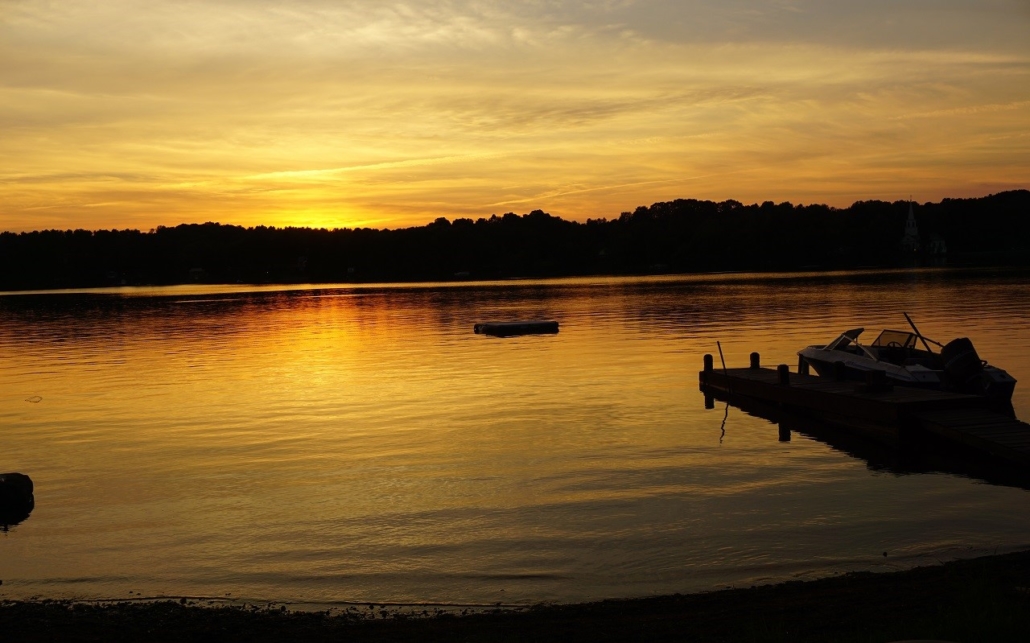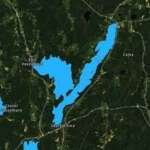China LakeSmart Program: Let’s Talk Lawns

photo by Eric Austin
The Challenge As a general rule, lawns don’t provide lake protection equivalent to other highly vegetated areas. Rainwater easily flows over lawns, and the tiny grass roots cannot hold soil together. Substantial erosion often occurs over lawns, even if no soil loss is noticeable. When nutrient rich soil reaches our lakes, there can be major consequences to lake health. However, with proper maintenance and design, landowners can have lawns while mitigating these lake-harming effects.
A lakefront property can maintain a beautiful lawn, while still being Lakesmart. These property owners include a large natural buffer between the lake and the lawn, add a defined narrow path, and strategically slope the lawn to avoid erosion. Additionally, they avoid fertilizers, and leave lawn clippings in place.
What to Do? Protecting your lake from lawn runoff requires quick infiltration into the ground. There are several ways to infiltrate lawn runoff effectively. Read on to learn more about what you can do.
● Love your lakeshore buffer: There is no substitute for an effective vegetated buffer lakeside of the lawn. A multi-tiered buffer infiltrates runoff while holding the lake shore in place. Encourage native vegetation in the buffer and allow pine needles and leaves to accumulate.
● Maintain your narrow, meandering path: The footpath from your lawn to the lake should not become a channel for water flow. Keep your footpath narrow and be sure it quickly diverts water off the path and into the buffer. Allow pine needles and leaves to accumulate on the path.
● Where the slope is moderate or severe, consider infiltration steps as part of the path: Infiltration steps will stop water flow down a slope when fast-running runoff would otherwise cause havoc. It will also make walking your path safer.
● Slope your lawn strategically: Keep lawn runoff away from the footpath, if possible, by sloping the lawn so water flows directly into an adjacent vegetated buffer.
● Mow your lawn using the highest mower setting and leave clippings to mulch in place: Both techniques stimulate turf development, making your lawn more drought resistant. Clippings feed the lawn, eliminating any need to use fertilizer. (Maine soils contain enough phosphorous to sustain lawns without fertilizer in any event.) And longer grass maximizes its resistance to flowing water.
For more information about making your property more lake-friendly, contact Christian Oren at the Lakes Environmental Association. Christian can be reached at 207-647-8580 and christian@leamaine.org.
If you would like to have a trained China LakeSmart volunteer visit your lakefront property to give you ideas that would help to protect the lake from harmful runoff, please contact us at ChinaLakeSmart@gmail.com. The Youth Conservation Corp can offer assistance to help with any Best Management Practices!
Responsible journalism is hard work!
It is also expensive!
If you enjoy reading The Town Line and the good news we bring you each week, would you consider a donation to help us continue the work we’re doing?
The Town Line is a 501(c)(3) nonprofit private foundation, and all donations are tax deductible under the Internal Revenue Service code.
To help, please visit our online donation page or mail a check payable to The Town Line, PO Box 89, South China, ME 04358. Your contribution is appreciated!





Leave a Reply
Want to join the discussion?Feel free to contribute!